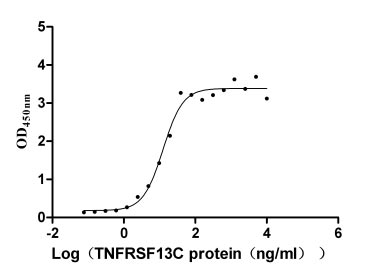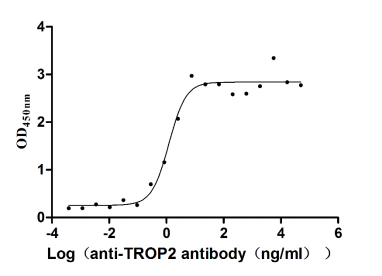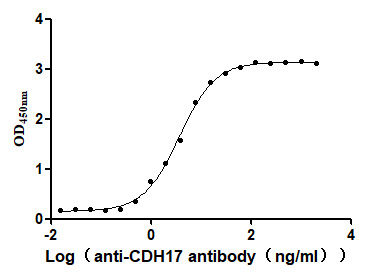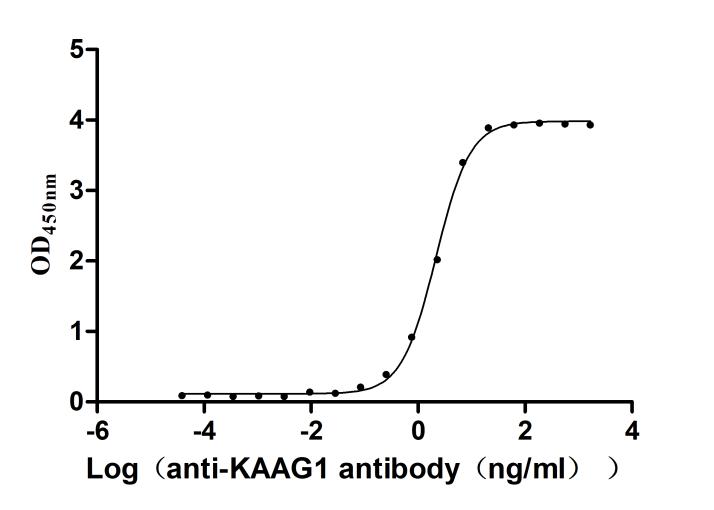Recombinant Mouse Apolipoprotein D (Apod)
-
中文名稱:Recombinant Mouse Apolipoprotein D(Apod)
-
貨號:CSB-YP001935MO
-
規(guī)格:
-
來源:Yeast
-
其他:
-
中文名稱:Recombinant Mouse Apolipoprotein D(Apod)
-
貨號:CSB-EP001935MO-B
-
規(guī)格:
-
來源:E.coli
-
共軛:Avi-tag Biotinylated
E. coli biotin ligase (BirA) is highly specific in covalently attaching biotin to the 15 amino acid AviTag peptide. This recombinant protein was biotinylated in vivo by AviTag-BirA technology, which method is BriA catalyzes amide linkage between the biotin and the specific lysine of the AviTag.
-
其他:
-
中文名稱:Recombinant Mouse Apolipoprotein D(Apod)
-
貨號:CSB-BP001935MO
-
規(guī)格:
-
來源:Baculovirus
-
其他:
-
中文名稱:Recombinant Mouse Apolipoprotein D(Apod)
-
貨號:CSB-MP001935MO
-
規(guī)格:
-
來源:Mammalian cell
-
其他:
產品詳情
-
純度:>85% (SDS-PAGE)
-
基因名:Apod
-
Uniprot No.:
-
別名:ApodApolipoprotein D; Apo-D; ApoD
-
種屬:Mus musculus (Mouse)
-
蛋白長度:Full length protein
-
表達區(qū)域:21-189
-
氨基酸序列QNFHLGKCPS PPVQENFDVK KYLGRWYEIE KIPASFEKGN CIQANYSLME NGNIEVLNKE LSPDGTMNQV KGEAKQSNVS EPAKLEVQFF PLMPPAPYWI LATDYENYAL VYSCTTFFWL FHVDFVWILG RNPYLPPETI TYLKDILTSN GIDIEKMTTT DQANCPDFL
-
蛋白標簽:Tag?type?will?be?determined?during?the?manufacturing?process.
The tag type will be determined during production process. If you have specified tag type, please tell us and we will develop the specified tag preferentially. -
產品提供形式:Lyophilized powder
Note: We will preferentially ship the format that we have in stock, however, if you have any special requirement for the format, please remark your requirement when placing the order, we will prepare according to your demand. -
復溶:We recommend that this vial be briefly centrifuged prior to opening to bring the contents to the bottom. Please reconstitute protein in deionized sterile water to a concentration of 0.1-1.0 mg/mL.We recommend to add 5-50% of glycerol (final concentration) and aliquot for long-term storage at -20℃/-80℃. Our default final concentration of glycerol is 50%. Customers could use it as reference.
-
儲存條件:Store at -20°C/-80°C upon receipt, aliquoting is necessary for mutiple use. Avoid repeated freeze-thaw cycles.
-
保質期:The shelf life is related to many factors, storage state, buffer ingredients, storage temperature and the stability of the protein itself.
Generally, the shelf life of liquid form is 6 months at -20°C/-80°C. The shelf life of lyophilized form is 12 months at -20°C/-80°C. -
貨期:Delivery time may differ from different purchasing way or location, please kindly consult your local distributors for specific delivery time.Note: All of our proteins are default shipped with normal blue ice packs, if you request to ship with dry ice, please communicate with us in advance and extra fees will be charged.
-
注意事項:Repeated freezing and thawing is not recommended. Store working aliquots at 4°C for up to one week.
-
Datasheet :Please contact us to get it.
相關產品
靶點詳情
-
功能:APOD occurs in the macromolecular complex with lecithin-transport and binding of bilin. Appears to be able to transport a variety of ligands in a number of different contexts.
-
基因功能參考文獻:
- Study shows that in myelin maturation ApoD ultimately controls the removal of the sialic-rich hydrophilic glycocalyx, by maintaining functional integrity of lysosomes. A detailed analysis of the mechanism reveals that the proper localization of Neu1 and plasma membrane Neu3, as well as of the membrane-bound Fyn kinase, depend on ApoD. PMID: 29222871
- apoD protein levels are variable across different brain regions. PMID: 26829325
- It regulates amyloid plaque pathology in a mouse model of Alzheimer's disease PMID: 25784209
- apoD may be part of an intrinsic cardioprotective system, possibly as a consequence of its antioxidation activity. PMID: 24082102
- Changes in hypothalamus of ApoD(-/-) mice may indicate potential role of ApoD in regulation of endocrine functions of somatostatin in a receptor-dependent manner. PMID: 22581439
- Abeta25-35 induces neuroprotective ApoD expression in hippocampal cells in response to stress-induced growth arrest. PMID: 22398376
- The findings underscore the importance of ApoD in the regulation of plasma insulin levels and triglyceride metabolism, suggesting that ApoD plays an important role in the pathogenesis of dyslipidemia. PMID: 21632073
- The data of this study supported that ApoD contributes to the endurance of astrocytes and decreases their reactivity level in vitro and in vivo PMID: 21688324
- Scanning cytometry revealed PACAP/ApoD induced low density lipoprotein receptors (LDLR) and ApoE receptor 2 (apoER2) in NF200-positive cells. PMID: 20920539
- mRNA and protein expression profiles reveal that ApoD is functionally connected in an age-dependent manner to specific molecular programs triggered by injury. PMID: 20607718
- Apolipoprotein D plays a significant role in lipid metabolism. PMID: 20124557
- This study concluded that glutamatergic pathways seem to be particularly affected in ApoD(-/-) mice. PMID: 19963028
- Expression pattern of the lipocalin apolipoprotein D during mouse embryogenesis. PMID: 11744388
- Apolipoprotein D-immunolabeled cells are observed in select grey matter nuclei, including the globus pallidus, thalamus, and substantia nigra, and in white matter tracts within the internal capsule and cerebellum of Neimann-Pick type C mouse brain. PMID: 12815234
- apolipoprotein D and the lipogenic protein Spot 14 are LXR alpha and LXRB responsive genes both in vitro and in vivo PMID: 14703507
- ApoD messenger RNA expression was localised to the spiral ligament and spiral limbus, particularly in the suprastrial and supralimbral regions. PMID: 15668042
- These observations, together with its transcriptional up-regulation in the brain upon oxidative insult, identify ApoD as an acute response protein with a protective and therefore beneficial function mediated by the control of peroxidated lipids. PMID: 18419796
- Taken together, our results describe receptor and region specific changes in SST and SSTR subtypes expression in ApoD(-/-) mice brain, which may be linked to specific neurological disorders. PMID: 19465111
顯示更多
收起更多
-
亞細胞定位:Secreted.
-
蛋白家族:Calycin superfamily, Lipocalin family
-
組織特異性:Highest levels of expression in brain, testis, virgin mammary gland and salivary gland. Moderate levels in skeletal muscle, lactating mammary gland and thymus. Low levels in lung and lymph node. No expression in kidney, pancreas, liver or spleen.
-
數據庫鏈接:
Most popular with customers
-
Express system: Mammalian cell
Species: Homo sapiens (Human)
-
Recombinant Human Glypican-3 (GPC3) (G537R), partial (Active)
Express system: Mammalian cell
Species: Homo sapiens (Human)
-
Recombinant Mouse Retinol-binding protein 4 (Rbp4) (Active)
Express system: Mammalian cell
Species: Mus musculus (Mouse)
-
Recombinant Human Interleukin-17A (IL17A) (T26A) (Active)
Express system: Baculovirus
Species: Homo sapiens (Human)
-
Recombinant Human Tumor-associated calcium signal transducer 2 (TACSTD2), partial (Active)
Express system: Mammalian cell
Species: Homo sapiens (Human)
-
Recombinant Human C-type lectin domain family 4 member C (CLEC4C), partial (Active)
Express system: Mammalian cell
Species: Homo sapiens (Human)
-
Recombinant Human Cadherin-17 (CDH17), partial (Active)
Express system: Mammalian cell
Species: Homo sapiens (Human)
-
Recombinant Human Kidney-associated antigen 1 (KAAG1) (Active)
Express system: E.coli
Species: Homo sapiens (Human)



-AC1.jpg)

-AC1.jpg)













